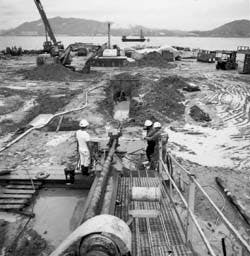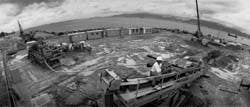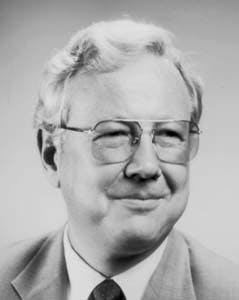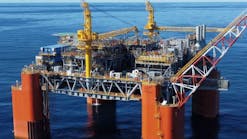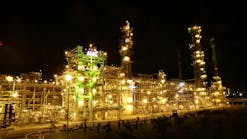Dan Callnon
Cherrington Corp.
SacramentoKen Weeks
KRW Associates
Sacramento
Directional drilling laid dual 12-in. natural gas pipelines beneath a critical sea wall on Lantau Island, Hong Kong New Territories, to complete a 30-mile gas-pipeline crossing of the South China Sea.
The project was part of Towngas Lantau construction for Hong Kong's new Chek Lap Kok International Airport on the island (Fig. 1 [30677 bytes]).
The Towngas Lantau Link project was managed by NKK Corp., Tokyo, as prime contractor for Hong Kong & China Gas Co. Ltd.
To avoid disturbing a newly installed sea wall at Ta Pang Po beach, NKK subcontracted parallel beach approaches to Cherrington Corp., Sacramento.
Between July 11 and Aug. 2, 1995, Cherrington Corp. drilled and forward-reamed two, 20 in., 1,294-ft holes to pull back the twin pipelines.
The project was completed during typhoon weather, high seas, strong currents, and logistical problems associated with operating in a remote uninhabited area.
Beach approach
Twin 12-in. OD, Grade API 5LX-52 pipelines had been laid in a subsea trench from the mainland to within 938 ft of the Ta Pang Po sea wall. Horizontal directional drilling (HDD) was employed to drill and forward-ream two parallel, 1,294 ft beach-approach holes beneath the sea wall and into the subsea trench.
Each hole was to exit approximately 90 ft from the product pipe, preinstalled in the sea floor trench, to allow for connection by divers before being pulled into place (Fig. 2 [39535 bytes]).
The design curve to clear the sea wall derived from the relationship among the entry point, the exit point, sea wall barrier geometry, and pipe diameter.
An entry angle of approximately 15, necessary to clear the lowest portion of the sea wall from the entry point, and a radius of curvature of 1,200 ft were maintained to achieve an exit angle of 90, or horizontal, into the subsea trench.
Entry points were 170.6 ft south of the sea wall at Ta Pang Po Beach and 18.04 ft above mean sea level (Fig. 3). The exit point was 1,184.38 ft north of the sea wall and 55.45 ft below mean sea level.
Horizontal distance of each hole was 1,294 ft (394 m) from the entry point. Soil conditions through which the twin holes were drilled consisted of large-diameter rock fill and marine deposits of soft silty clay with sand, angular rocks, and gravels.
Pilot holes (9-in. OD) were drilled from each site. Each hole was forward reamed with a 20-in. hole opener tipped with a bull nose and rear mounted stabilizer.
Installation of the dual gas-pipeline beach approach was assisted by five professional divers supported by two surface vessels. Divers were critical to the success of the project facilitating the installation of the product pipe during pull-back operations as well as locating the exit of each pilot hole in relation to the existing trench.
Logistics required special consideration because Lantau Island had few facilities or public infrastructure. All equipment, supplies, and temporary facilities had to be mobilized to the island before work could start.
Weather and rough seas caused major problems to the project's logistical support: crew and supplies had to be transported 30 miles across the South China Sea each day.
Strong currents, low underwater visibility, rough seas, and weather also complicated the efforts of the divers, who were critical to the pull back operation.
This directional drilling rig was moved 5 m west to drill a parallel entry hole (Fig. 3).
Staging, site preparation
Two gravity-base foundations consisting of concrete blocks (M2 Type or equivalent) were placed on the sea bed.
Two foot bridges approximately 36 ft long were fabricated and installed between the first concrete base, the second concrete base, and the slope sea way. This was necessary to accommodate the personnel and supplies daily brought to the island by crew boats.
One 125-kva diesel generator was mobilized and maintained at the job site to supply power. Electrical power was supplied to two portable office structures and lighting for night operations.
Because no potable water supply existed near the work area, bottled drinking water was furnished. Water for the drilling operation was obtained from a nearby stream.
Portable toilet units were mobilized and maintained for the use of the HDD crew.
Portable cellular telephones and walkie-talkies provided communications at the Ta Pang Po work area.
Before the HDD equipment was installed at Ta Pang Po Beach, three survey hubs (markers) were placed along the proposed path of the two pilot holes in line with each of the entry points. Each hub, or survey point, served as the reference for azimuth and inclination calculations during drilling operations.
In addition to these reference hubs, buoys marked the center of each of the proposed exit points within the trench as well as the ends of the product pipes that were to be pulled into place from the sea floor.
The dual strings of product pipe were laid approximately 90 ft away from the planned exit points to allow room for alignment and connection of the drill pipe prior to pull back. Divers checked the actual exit point of each pilot hole to confirm its specific horizontal and vertical position.
Before installing the HDD rig, a deadman anchoring system was installed at the site to withstand 300,000 lb of pulling force. The deadman system consisted of I-beams placed in a trench with a concrete cap.
Because a box culvert traversed closely under the rig location (Fig. 4 [24344 bytes]), a special anchoring system, consisting of conventional H-beams with two additional concrete blocks on each side of the box culvert, was used for further stability. The rig was placed on a timber mat to protect the box culvert.
Otherwise, no special preparation was necessary for the rig staging area.
Cherrington's Rig No. 1 was used for the project (Fig. 5). It has 75,000 lb of thrust, up to 300,000 lb of pull-back capacity and 30,000 ft-lb of rotary torque. The rig requires a crew of five, including a surveyor and a superintendent.
Mud pumps for the HDD rig used on Ta Pang Po Beach approach flow into the east pilot hole (Fig. 5).
Drilling
A spud jet was used hydraulically to penetrate softer formations like sands, silts, and clays.
The successful installation of the twin gas lines at Ta Pang Po Beach was the result of high-quality surveying techniques. Innovative methods not only enabled each pilot hole to clear the lower extent of the sea wall (approximately 20 ft below the surface and 170.6 ft north of the entry point) but to also exit within 2 ft of their planned targets.
Furthermore, both pilot holes exited 16.4 ft apart and within 90 ft of the product pipe in the subsea trench (Fig. 6 [43652 bytes]).
Directional heading information (azimuth and inclination) was updated every 8 sec during drilling by a wireline steering tool. The tool's north referencing, three-axis magnetometer and a tri-axial accelerometer-sensor package provided azimuth and inclination data to the directional driller while drilling each pilot hole.
The steering tool was placed within a nonmagnetic bottom hole assembly (BHA; Fig. 7 [53915 bytes]). This was typically three, 30-ft sections of aluminum drill pipe just above the bit.
Azimuth and inclination were monitored during the entire drilling operation with stationary surveys taken every 30 ft and, if required, 15 ft.
A guidance tracking system, in addition to the wireline steering tool, was used. The tracking grid or coil was laid out according to the depth of the proposed trajectory of each hole and was set-up on the land surface, adjacent the sea wall, to correspond with the proposed depth of the drilled path.
A magnetic field is set up from current flow through the coils. The downhole probe, or special steering tool, senses this current and triangulates the location of the drill head by using this known geometry.
Prior to drilling operations, soil samples were taken to anticipate mud properties required. Drilling mud was used for jetting each pilot hole to reduce the friction and to support the borehole during prereaming, reaming, and pull-back operations.
Drilling mud was a mixture of water and bentonite. Viscosity and density of the bentonite mud ranged from 60 sec/cc and 8.7-8.9 ppg (1.04-1.06 gm/cc) during drilling.
Viscosity was increased to greater than 100 sec to maintain hole integrity as drill pipe was withdrawn from each pilot hole before reaming.
Reserve pits were constructed on location to store used mud. It is worth noting that a minimal amount of drilling mud escaped into the sea upon exiting the subsea trench.
After the setting of 95/8-in. OD casing through the slurry trench and fill zone, two pilot holes, beginning with the easterly one, were drilled due north by jetting a 9-in. hole, 1,294 ft, into the sea floor trench.
Bubbles mark exit spots
When the drill pipe exited into the trench, air was pumped through the drill pipe so that divers could verify the exit point and mark it with buoys.
As the pipe was tripped out of the hole, high viscosity bentonite mud (viscosity = 100+ sec, density = 8.7-8.9 ppg, 1.04-1.06 gm/cc) was injected into the hole to maintain its integrity.
The rig was then moved 16.4 ft (5 m) to the west, and a parallel pilot hole, identical to the first, was jetted into the subsea trench within 2 ft of the projected target.
Air was once again pumped through the drill pipe while divers verified and marked its exit point. As in the case of the first pilot hole, high viscosity bentonite mud was injected into the hole to maintain hole integrity as the pipe was tripped out.
A 20-in. forward reamer with bull-nose and rear stabilizer was then used to open the westerly hole from 9 in. to 20 in. to accommodate the 12-in. OD product pipe. Bentonite mud was circulated during the reaming process to clean the hole and create a suitable medium in which to pull back the product pipe.
Once the 20-in. reamer had exited into the subsea trench, divers removed the special bull nose and attached a swivel assembly to the drill pipe.
The drill pipe was then pushed 90 ft forward into the trench so that divers could maneuver the reamer and swivel assemblies for attachment to the product pipe and pull-back.
Upon pulling the product pipe into the westerly hole, the rig was again moved to the east hole. Drill pipe, with specially designed bull nose, was run back into the hole to ensure that the hole had not lost its integrity.
The 95/8-in. surface casing was removed; a 20-in. reamer with bull nose and rear stabilizer was then used to open the hole from 9 in. to 20 in.
The same procedure used on the westerly hole was followed at the exit point. Air was pumped through the drill pipe for divers to locate and mark.
The pulling assembly was affixed and the drill pipe extended 90 ft so that it could be maneuvered into place for connection to the product pipe and pull back.
After installing both product pipes, divers welded the final sections together within the sea floor trench. Likewise, surface connections were made and the slurry hole at the entry point of each hole was back filled to complete the installation.
Weather conditions, especially typhoon-force winds that limited subsea visibility (down to 3.28 ft) and 6-kt currents, made work for the divers difficult.
Before its placement, product pipe laid in the trench in preparation of the placement beneath the sea wall was covered with sediments on the sea floor by strong cross currents (Fig. 8 [25710 bytes]). This required special efforts by the divers to uncover the product pipe so that it could be moved into place for pull back.
These adverse circumstances required special operating techniques and a BHA configuration to facilitate product pipe connections to minimize the time required for divers to work under water and successfully complete the project.
The Authors
Daniel P. Callnon is vice-president for business development of Cherrington Corp., Sacramento, which he joined in 1988. He had previously (1973-1988) worked for Titan Contractors. He has also worked in civil and building construction for 5 years as general foreman and superintendent.
Kenneth R. Weeks is a technical marketing consultant to the petroleum industry and principal of KRW Associates, Sacramento. He began his career with Schlumberger and spent 14 years as marketing executive for, among other international service companies, Gearhart Industries, Geotronics, and two former Baker Hughes subsidiaries, Exlog and Develco. He has lectured on MWD topics at Stanford University's Petroleum Engineering Department and was 1989-90 Distinguished Lecturer for the SPE on MWD. Weeks holds a degree in geology from the University of California, Santa Barbara.
Copyright 1996 Oil & Gas Journal. All Rights Reserved.
